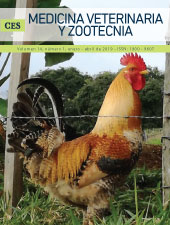Insights on the canine mitral valve in the course of myxomatous mitral valve disease
DOI:
https://doi.org/10.21615/cesmvz.14.1.4Resumen
Myxomatous mitral valve disease (MMVD) is the most common heart alteration in dogs. A vast extent of research has been focused on echocardiographic tissue Doppler and strain indices and the medical treatment of this condition, which are beyond the scope of this article. This review intends to include less known information of the mitral valve, acknowledge the American College of Veterinary Internal Medicine (ACVIM) consensus on MMVD and state different surgical approaches and devices, all valuable information for small animal clinicians and cardiologists. Also, during the last decade studies have been oriented towards to understand valve’s mechanical structure and function, genes involved in the etiology and molecular signaling pathways. Advances have been made in understanding the mitral valve, but more assessment and efforts are needed in this specific area.
Información sobre la válvula mitral canina en el curso de la degeneración mixomatosa valvular mitral
La degeneración mixomatosa valvular mitral (MMVD) es la alteración cardíaca más común en perros. Una gran parte de la investigación se ha centrado en índices ecocardiográficos de doppler tisular y strain y la terapéutica médica de esta afección, aspectos que están más allá del alcance de este artículo. Esta revisión pretende incluir información menos difundida de la válvula mitral, señalar el consenso del Colegio Americano de Medicina Interna Veterinaria (ACVIM) sobre el MMVD y conocer diferentes métodos y dispositivos quirúrgicos, toda información valiosa para clínicos de caninos y felinos y cardiólogos. Adicionalmente, durante la última década, los estudios se han orientado a comprender la biomecánica y la función de las válvulas, los genes involucrados en la etiología y las vías de señalización molecular. Se ha avanzado en el entendimiento de la válvula mitral, pero más revisiones y esfuerzos son necesarios en esta área específica.
Palabras clave: cardiología, corazón, perro, válvula atrioventricular.
Percepções sobre a válvula mitral canina no curso da doença mitral mixomatosa
A doença valvar mitral mixomatosa (DMVM) é a alteração cardíaca mais comum em cães. Uma vasta extensão da pesquisa tem sido focada nos índices de Doppler tecidual e de strain ecocardiográfico e no tratamento médico dessa condição, que estão além do escopo deste artigo. Esta revisão pretende incluir informações menos conhecidas sobre a válvula mitral, reconhecer o Consenso do Colégio Americano de Medicina Interna Veterinária (ACVIM) sobre MMVD e indicar diferentes abordagens e dispositivos cirúrgicos, todas informações valiosas para clínicos e cardiologistas de pequenos animais. Além disso, durante a última década, os estudos foram orientados para entender a estrutura mecânica e a função da válvula, genes envolvidos nas vias de etiologia e sinalização molecular. Avanços foram feitos no entendimento da valva
mitral, mas mais avaliações e esforços são necessários nessa área específica.
Palavras-chave: cão, cardiología, coração, válvula atrioventricular.
Descargas
Referencias bibliográficas
Alegret, M., Peretó, M., Pérez, A., Valero, S., Espinosa, A., Ortega, G., . . . Vargas, L. (2018). The Role of Verb Fluency in the Detection of Early Cognitive Impairment in Alzheimer’s Disease. Journal of Alzheimer's Disease, 62(2), 611-619.
Alves Gonçalves, H., Cargnin, C., Machado Jacobsen, G., Kochhann, R., Joanette, Y., & Fonseca, R., F. (2017). Clustering and switching in unconstrained, phonemic and semantic verbal fluency: the role of age and school type. Journal of Cognitive Psychology, 29(6), 1-21. doi: http://dx.doi.org/10.1080/20445911.2017.1313259
Anderson, V., Anderson, P., Northram, E., Jacobs, R., & Catroppa, C. (2001). Development of executive functions through late childhood and adolescence in an Australian sample. Developmental Neuropsychology, 20, 385-406. doi: http://dx.doi.org/10.1207/S15326942DN2001_5
Andreou, G., & Trott, K. (2013). Verbal fluency in adults diagnosed with attention-deficit hyperactivity disorder (ADHD) in childhood. Atten.Defic. Hyperact.Disord, 5, 343–351. doi: http://doi.org/doi:10.1007/s12402-013-0112-z
Arán-Filippetti, V. (2011). Fluidez verbal según tipo de tarea, intervalo de tiempo y estrato socioeconómico, en niños escolarizados. Anales de Psicología, 27(3), 816-826.
Arán-Filippetti, V. (2011). Funciones ejecutivas en niños escolarizados: efectos de la edad y del estrato socioeconómico. Avances en Psicología Latinoamericana, 29(1), 98-113.
Berninger, V. W., & Colwell, S. O. (1985). Relationship between neurodevelopmental and educational findings in chidren aged 6 to 12 years. Pediatrics, 75(4), 697-702.
Bolla, K., Lindgren, K., Bonaccorsy, C., & Bleecker, M. (1990). Predictors of verbal fluency (FAS) in the healthy elderly. Journal of Clinical Psychology, 46, 623-628. doi: http://dx.doi.org/10.1002/1097-4679(199009)46:5%3C623::AID-JCLP2270460513%3E3.0.CO;2-C
Butman, J., Allegri, R. F., Harris, P., & Drake, M. (2000). Fluencia verbal en español. Medicina, 60, 561-564.
Cattell, R. B. (1978). The scientific use of factor analysis. New York: Plenum.
Cohen, L., Manion, L., & Morrison, K. (2003). Research Methods in Education. London: Routledge Falmer.
Collins, A., & Loftus, E. F. (1975). A spreading-activation theory of semantic processing. Psychological Review, 82, 407-428. doi: http://dx.doi.org/10.1037//0033-295X.82.6.407
Fumagalli, J., Shalóm, D., Soriano, F., Carden, J., Cabañas Fale, P., Tomio, A., . . . Martínez-Cuitiño, M. (2015). Normas categoriales para una muestra de hablantes adultos del español de Argentina. Evaluar, 15, 1-40.
Fumagalli, J., Soriano, F., Shalóm, D., Barreyro, J. P., & Martínez-Cuitiño, M. (2017). Phonological and semantic verbal fluency tasks in a sample of Argentinean children. Trends in Psychology, 25(3), 995-1005. doi: http://dx.doi.org/10.9788/TP2017.3-05En
Gaillard, W. D., Herthz-Pannier, L., Mott, S. H., Barnett, A. S., LeBihan, D., & Theodore, W. H. (2000). Functional anatomy of cognitive development, fMRI of verbal fluency in children and adults. Neurology, 54, 180-185. doi: http://dx.doi.org/10.1212/WNL.54.1.180
García Coni, A., & Vivas, J. (2014). Estrategias ejecutivas de búsqueda, recuperación y cambio en la fluidez verbal. Evaluar, 14, 15-42.
Goodglass, H., & Weintraub, S. (Eds.). (1983). The Boston Naming Test. Philadelphia, PA.
Gorsuch, R. L. (1983). Factor analysis (2nd ed.). Hillsdale, NJ: Erlbaum.
Halperin, J. M., Healey, J. M., Zeitchik, E., Ludman, W. L., & Weinstein, L. (1989). Developmental aspects of linguistic and mnestic abilities in normal children. Journal of Clinical and Experimental Neuropsychology, 11, 518-528. doi: http://dx.doi.org/10.1080/01688638908400910
Hirshorn, E., & Thompson-Schill, S. (2006). Role of the left inferior frontal gyrus in covert word retrieval: Neural correlates of switching during verbal fluency. Neuropsychologia, 44, 2547-2557. doi: http://dx.doi.org/10.1016/j.neuropsychologia.2006.03.035
Hurks, P. P. M., Hendriksen, J. G. M., Vles, J. S. H., Kalff, A. C., Feron, F. J. M., Kroes, M., . . . Jolles, J. (2004). Verbal fluency over time as a measure of automatic and controlled processing in children with ADHD. Brain and Cognition, 55, 535-544. doi: http://dx.doi.org/10.1016/j.bandc.2004.03.003
Hurks, P. P. M., Vles, J. S. H., Hendriksen, J. G. M., Kalff, A. C., Feron, F. J. M., Kroes, M., . . . Jolles, J. (2006). Semantic category fluency versus initial letter fluency over 60 seconds as a measure of automatic and controlled processing in healthy school-aged children. Journal of Clinical and Experimental Neuropsychology, 28, 684-695. doi: http://dx.doi.org/10.1080/13803390590954191
Jacobsen, G. M., de Mello, C. M., Kochhann, R., & Fonseca, R. P. (2017). Executive Functions in School-age Children: Influence of Age, Gender, School Type and Parental Education. Appl. Cognit. Psychol., 31, 404-413. doi: http://dx.doi.org/doi:10.1002/acp.3338
Jacobsen, G. M., Liberatore Prando, M., Moraes, A. L., da Rosa Pureza, J., Alves Gonçalves, H., de Souza Siqueira, L., . . . Fonseca, R. P. (2016). Effects of Age and School Type on Unconstrained, Phonemic, and Semantic Verbal Fluency in Children. Applied Neuropsychology: Child. doi: http://dx.doi.org/10.1080/21622965.2015.1072535
Kochhann, R., Alves Gonçalves, H., da Rosa Pureza, J., Fante Viapiana, V., dos Passos Fonseca, F., Fonseca, R. P., & Fumagali Salles, J. (2017). Variability in neurocognitive performance: Age, gender, and schoolrelated differences in children and from ages 6 to 12. Applied Neuropsychology: Child. doi: http://dx.doi.org/10.1080/21622965.2017.1312403
Marino, J., & Alderete, A. M. (2008). Actividad cognitiva en pruebas de fluidez verbal. Tesis doctoral, Universidad Nacional de Córdoba, Córdoba.
Marino, J., & Alderete, A. M. (2010). Valores Normativos de Pruebas de Fluidez Verbal Categoriales, Fonológicas, Gramaticales y Combinadas y Análisis Comparativo de la Capacidad de Iniciación. Revista Neuropsicología, Neuropsiquiatría y Neurociencias, 10(1), 79-93.
Marino, J., & Díaz-Fajreldines, H. (2011). Pruebas de fluidez verbal categoriales, fonológicas y gramaticales en la infancia: factores ejecutivos y semánticos. Revista Chilena de Neuropsicología, 6(1), 49-56.
McMillan, J. H., & Schumacher, S. (2001). Research in Education: A Conceptual Introduction. New York: Addioson Wesley Longman.
Murphy, L. A., Pollatsek, A., & Well, A. D. (1998). Developmental dyslexia and word retrieval deficits. Brain and Language, 35, 1-23. doi: http://dx.doi.org/10.1016/0093-934X(88)90099-5
Nieto, A., Galtier, I., Barroso, J., & Espinosa, G. (2008). Fluencia verbal en niños españoles en edad escolar: estudio normativo piloto y análisis de las estrategias organizativas. Revista Neurologica, 46(1), 2-6.
Riva, D., Nichelli, F., & Devoti, M. (2000). Developmental Aspects of Verbal Fluency Confrontation Naming in Children. Brain and Language, 71, 267-284. doi: http://dx.doi.org/10.1006/brln.1999.2166
Ruff, R. M., Light, R. H., Parker, S. B., & Levin, H. S. (1997). The psychological construct of word fluency. Brain and Language, 57, 394-405. doi: http://dx.doi.org/10.1006/brln.1997.1755
Sautú, R. (1991). Oportunidades ocupacionales diferenciales por sexo en Argentina: 1970/1980. Paper presented at the Estudios del Trabajo, Buenos Aires.
Sauzéon, H., Lestage, P., Raboutet, C., Kaoua, B. N., & Claverie, B. (2004). Verbal fluency output in children aged 7–16 as a function of the production criterion: Qualitative analysis of clustering, switching processes, and semantic network exploitation. Brain and Language, 89, 192-202.
Shao, Z., Janse, E., Visser, K., & Meyer, A. S. (2014). What do verbal fluency tasks measure? Predictors of verbal fluency performance in older adults. Frontiers in Psychology, 5,772. doi: http://doi.org/10.3389/fpsyg.2014.00772
Soriano, F., Fumagalli, J., Shalóm, D., Barreyro, J. P., & Martínez-Cuitiño, M. (2018). Diferencias entre niños y adultos de ambos sexos en tareas de fluencia semántica: ¿Innatas o culturales? Revista Psiencia. Revista Latinoamericana de Ciencia Psicológica, 10(1). doi: http://doi.org/10.5872/psiencia/10.1.25
Spreen, O., & Strauss, E. A. (1998). Compendium of neuropsychological tests (2nd ed.). New York, NY: Oxford Univesity Press.
Stuss, D. T., Alexander, M. P., Hamer, L., Palumbo, C., Dempster, R., Binns, M., . . . Izukawa, D. (1998). The effects of focal anterior and posterior brain lesions on verbal fluency. Journal of the International Neuropsychological Society, 4, 265-278.
Temple, C. M. (1997). Developmental cognitive neuropsychology. Hove: UK: Psychology Press.
Van der Elst, W., Hurks, P., Wassenberg, R., Meijs, C., & Jolles, J. (2011). Animal Verbal Fluency and Design Fluency in school-aged children: Effects of age, sex, and mean level of parental education, and regression-based normative data. Journal of Clinical and Experimental Neuropsychology, 33(9), 1005-1015. doi: http://dx.doi.org/doi:10.1080/13803395.2011.589509
Wolf, M. (1984). Naming, reading, and the dyslexias: A longitudinal overview. Annals of Dyslexia, 34, 87-115.
Wolf, M., & Goodglass, H. (1986). Dyslexia, dysnomia, and lexical retrieval: A longitudinal investigation. Brain and Language, 28, 154-168. doi: http://dx.doi.org/10.1016/0093-934X(86)90098-2
Wolf, M., & Obregón, M. (1992). Early naming deficits, developmental dyslexia, and a specific deficit hypothesis. Brain and Language, 42, 219-247. doi: http://dx.doi.org/10.1016/0093-934X(92)90099-Z
Zhao, Q., Guo, Q., & Hong, Z. (2013). Clustering and switching during a semantic verbal fluency contribute to differential diagnosis of cognitive impairment. Neurosci.Bull. , 29, 75-82. doi: http://doi.org/10.1007/s12264-013-1301-7
Descargas
Publicado
Cómo citar
Número
Sección
Licencia
Derechos de autor 2019 CES Medicina Veterinaria y Zootecnia

Esta obra está bajo una licencia internacional Creative Commons Atribución-NoComercial-CompartirIgual 4.0.
| Estadísticas de artículo | |
|---|---|
| Vistas de resúmenes | |
| Vistas de PDF | |
| Descargas de PDF | |
| Vistas de HTML | |
| Otras vistas | |



